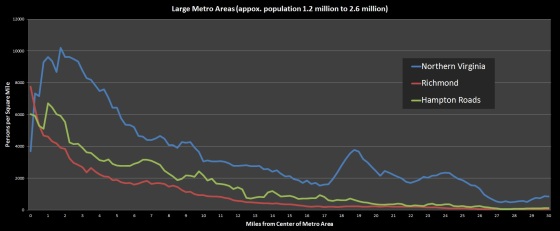Recently, I’ve been comparing a number of traits of metropolitan areas based on distance from the core. Here I’m looking at the average densities of each metro area as you travel outwards from the center, calculated using census blocks and 2010 short-form census data. I’ve graphed them in groups of three. Cities with a strong core will have high densities on the left (near the center) that fall off as you travel outwards. Cities whose densities fall off quickly on the right have clearer edges, while those that taper off slowly are more spread out. Click on the graphs to view them full screen.
First are the three major metro areas. Note that the Northern VA graph includes only Virginia census blocks, not the rest of the DC area. Northern VA has the largest population by far, with fairly high densities even several miles into the suburbs. Richmond has the smoothest curve. I used downtown Norfolk as the core for Hampton Roads, but the area’s polycentricity is obvious.




